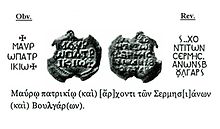Kuber: Difference between revisions
No edit summary |
|||
| Line 17: | Line 17: | ||
==Honour== |
==Honour== |
||
[[Kuber Peak]] in [[Tangra Mountains]] on [[Livingston Island]] in the [[South Shetland Islands]], [[Antarctica]] is named after Kuber. |
[[Kuber Peak]] in [[Tangra Mountains]] on [[Livingston Island]] in the [[South Shetland Islands]], [[Antarctica]] is named after Kuber. |
||
==[http://www.shaligram.com/Exotic_Laxmi_Kuber-191.htm Kuber Shaligram Shila For Pooja]== |
|||
Laxmi Kuber is the goddess of fortune, which usually and simplistically translates Her as wealth. But the actual Yaksha who supervise and does the security of wealth in the Indian ethos has been Kuber. He is the ruler of a fabulous hidden city in the Himalayas called Alkapuri, which has all the stored up wealth of the Earth. |
|||
==References== |
==References== |
||
Revision as of 06:57, 8 August 2013
Kuber (also Kouver or Kuver) was a Bulgar leader, son of Kubrat, brother of Khan Asparukh and member of the Dulo clan,[citation needed] who according to the Miracles of Saint Demetrius was the leader, in the 670s, of a mixed Christian population whose ancestors had been transferred from the Eastern Roman Empire to the Syrmia region in Pannonia by the Avars 60 years earlier.[1][2]
Kuber's rule in Pannonia
In Pannonia, Kuber was the Khagan's governor, and ruled in the area surrounding the town of Sirmium,[3] which was Kuber's capital.[4] The Miracles of St Demetrius states that, circa 680 AD, Kuber had a falling out with the Avar khagan, and after repelling an Avar attack, led his followers of around 70,000 people,[5] from Syrmia to Macedonia (modern Republic of Macedonia). The Byzantines initially called his people Sermisianoi (after their former settlement - Sirmium), and later the Keramisians (after their new place: the Keramisian plain in Greater Macedonia).
Kuber's people in Macedonia
In Macedonia, they had contacts and possibly mixed with the Dragovites - a Slavic tribe in the region.[1][2] Some of his people wanted to disperse to their respective various homelands. Since they were Christians, they were probably once imperial subjects that were captured by the Avars. Kuber asked the Byzantine Emperor Constantine IV to not allow the dispersal of his people, fearing that his power will decline.[citation needed] Rebuffed by the Emperor, he resolved to attack Thessaloniki, but failed. He probably made a few other sporadic attacks on the Byzantines. Professor Vasil Zlatarski, a Bulgarian scholar, suggests that Kuber was the "unnamed son" of Great Kubrat. Certainly, being a prominent prince would explain why the Avars gave him rule, and his appearance in 670 chronologically fits the downfall of Old Bulgaria. He also suggests that Kuber's people represented a second Balkan Bulgar "state" in Macedonia, parallel to that of his brother's Asparukh realm in the north-eastern Balkans. Whether he had established a state of sorts or not, nothing is mentioned of Kuber after the 680s,[1] but in the beginning of the 8th century Asparukh's son, Tervel, is said to have cooperated with "his uncles" from Macedonia.[6] His people mixed with the local Slavs living in the area, well before Khan Presian expanded his Bulgarian Empire into Macedonia in the early 800s.[7]

Archaeology
Macedonian archaeologist Ivan Mikulčić revealed the presence not only of the Kuber group, but an entire Bulgar archaeological culture throughout Macedonia and eastern Albania.[8] He describes the traces of Bulgars in this region, which consist of typical fortresses, burials, various products of metallurgy and pottery (including the treasures from Vrap and Erseke, with supposed Bulgar origin or ownership), lead seals, minted from Kuber, amulets, etc. However, part of this could actually represent traces of Avar presence. They are known to have raided as far south as Macedonia, and the material culture of the Avars was very similar to the Bulgars.[1]
Honour
Kuber Peak in Tangra Mountains on Livingston Island in the South Shetland Islands, Antarctica is named after Kuber.
Laxmi Kuber is the goddess of fortune, which usually and simplistically translates Her as wealth. But the actual Yaksha who supervise and does the security of wealth in the Indian ethos has been Kuber. He is the ruler of a fabulous hidden city in the Himalayas called Alkapuri, which has all the stored up wealth of the Earth.
References
- ^ a b c d Curta
- ^ a b Fine
- ^ Awarzy, Wojciech Szymański, Elżbieta Dąbrowska, Ossolineum, 1979, page 57.
- ^ The Journal of the Anthropological institute, Royal anthropological institute, 1882, page 227.
- ^ Средновековни градови и тврдини во Македониjа,(Скопjе, Македонска цивилизациjа, 1996) Иван Микулчик, стр. 71.
- ^ Веселин Бешевлиев, "Първобългарски надписи", Издателство на Българската академия на науките, София, 1979, стр. 94 / "Protobulgarian inscriptions", Publishing house of the Bulgarian Academy of Sciences, Sofia, 1979, p. 94
- ^ The early medieval Balkans. Fine
- ^ Иван Микулчиќ, "Средновековни градови и тврдини во Македониjа", Скопjе, "Македонска цивилизациjа", 1996, стр. 29-33 / "Medieval towns and strongholds in Macedonia", Skopje, Publishing house "Macedonian civilization", 1996, p. 29-33, in Macedonian
Further reading
- Curta, Florin (2006). Southeastern Europe in the Middle Ages, 500-1250. Cambridge Medieval Textbooks. ISBN 0-521-81539-8.
- Fine, Jr, John V.A (1991). The early Medieval Balkans; A critical survey from the sixth to the late twelfth century. The University of Michigan Press. ISBN 0-472-08149-7.
- Hupchik, Dennis P (2002). The Balkans. From Constantinople to Communism. Palgrave MacMillan. ISBN 1-4039-6417-3.
- Иван Микулчиќ, "Средновековни градови и тврдини во Македониjа", Скопjе, "Македонска цивилизациjа", 1996 (Macedonian); part of the book here.
